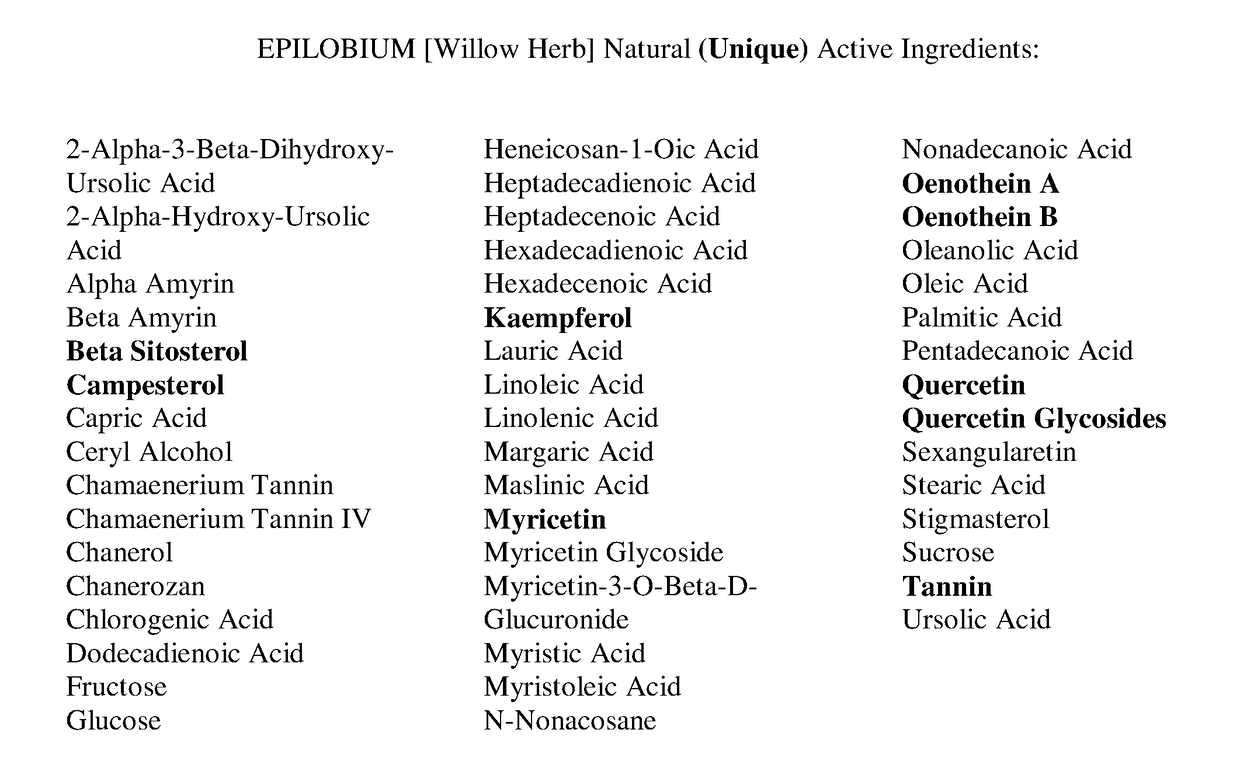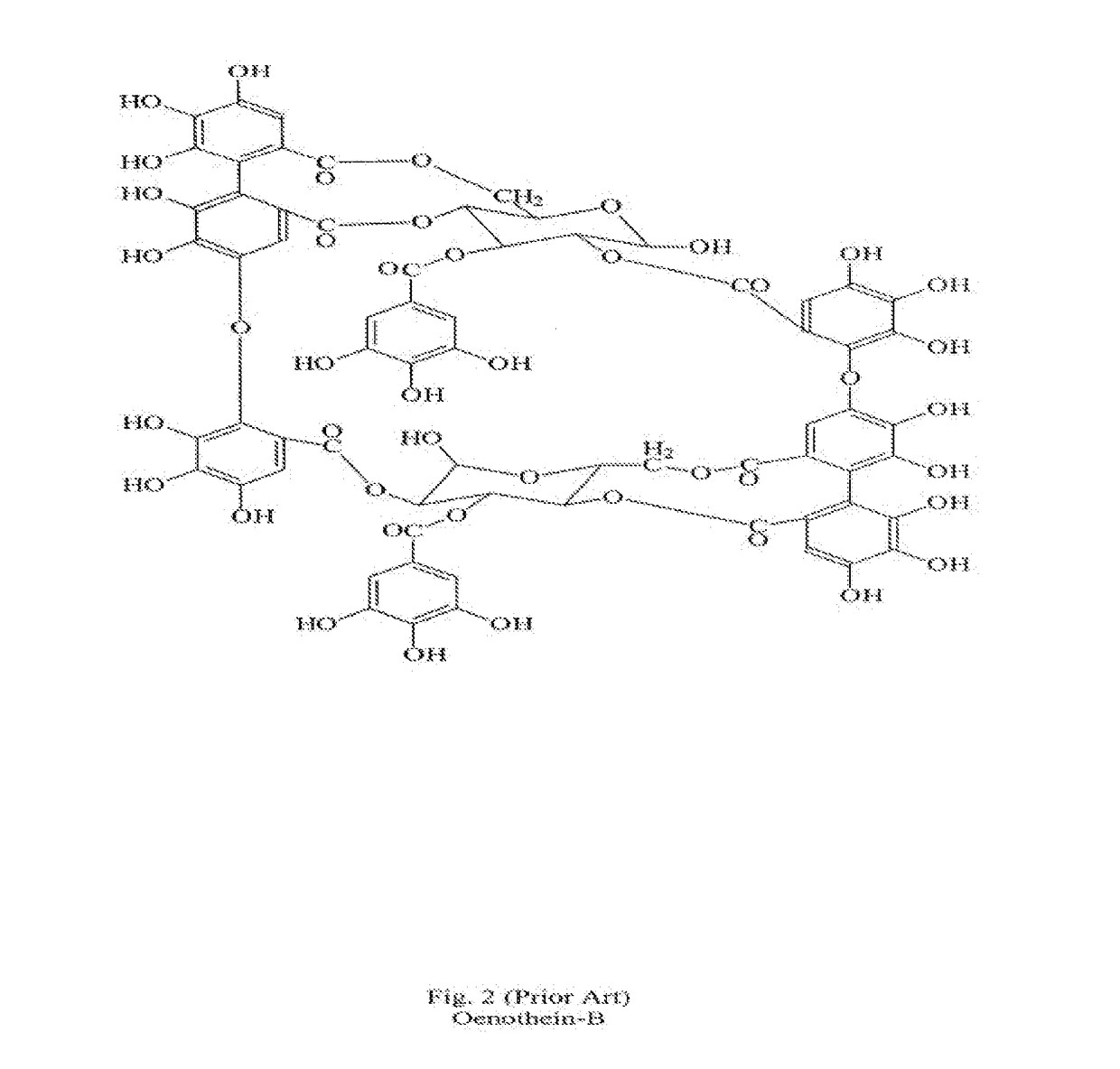Methods of use for oenothein a and b from epilobium species
a technology of oenothein and epilobium, which is applied in the field of compositions and uses of oenothein, can solve the problem that oenothein b (oeb) has quite low bioaccessibility for oral consumption, and achieve the effect of reducing inflammation
- Summary
- Abstract
- Description
- Claims
- Application Information
AI Technical Summary
Benefits of technology
Problems solved by technology
Method used
Image
Examples
example 1
Isolation and Purificationof Oenothein B
[0057]A purified aqueous extract was obtained from New World Epilobium angustifolium (Canadian Willow herb) and subjected to a variety of analytical techniques, which unambiguously identify the purified compound as oenothein B. This analysis included mass spectroscopy and nuclear magnetic resonance spectrometry. While oenothein B was found by these methods to be present in solvent-free aqueous extracts of Canadian Willow herb at levels up to 9.6%, myricetin glucuronide—the substance identified as the active ingredient of the anti-inflammatory action of Old World Epilobium angustifolium (U.S. Pat. No. 6,528,490 B2, see the Background section herein)—was not found in extracts of Canadian Willow herb.
example 2
Efficacy of Oenothein B to Treat Inflammation and Irritation
[0058]This example shows the effectiveness of the purified oenothein B characterized in Example 1 in treating inflammation and irritation.
[0059]In the hen's-egg chorioallantoic membrane (CAM) model, in which the CAM is treated with 15% lactic acid as a standard irritant, the development of manifestations of membrane irritation were tracked and scored according to published methods for assessing irritancy (Luepke and Kemper, 1986, Food and Chemical Toxicology 24: 495; Spielmann et al. 1997, Food and Chemical Toxicology 35:39). A sample of the oenothein B extract from Canadian Willow herb described in Example 1 was tested at a 1% (weight to volume) dilution for activity in the CAM model. The results showed a decrease in irritation by up to 70% when the oenothein B was applied before the irritant (simulating a prophylactic use) while an 80% decrease was seen with the whole aqueous extract itself.
[0060]Further testing was perfo...
example 3
Free Radical Scavenging Activity of Oenothein B
[0062]This example shows the free radical scavenging activity of oenothein B. A sample of the oenothein B extract from Canadian Willow herb described in Example 1 was assessed using the xanthine oxidase / acetaldehyde spectro photometric method, in which superoxide radical ions regenerated in vitro using acetaldehyde and xanthine oxidase, in the presence of test compounds (Fridovich, 1970, Journal of Biological Chemistry 245:4053; Hodgson and Fridovich, 1976, Biochimicaet Biophysica Acta 430:182). The scavenging of free super oxide radicals is quantitated spectrometrically and expressed in terms of percentage of radicals scavenged. Assays were performed with 1% (w / v) and 0.1% (w / v) dilutions of the dried extract, which yielded up to 100% scavenging activity and up to 99% scavenging activity respectively.
PUM
 Login to View More
Login to View More Abstract
Description
Claims
Application Information
 Login to View More
Login to View More - R&D
- Intellectual Property
- Life Sciences
- Materials
- Tech Scout
- Unparalleled Data Quality
- Higher Quality Content
- 60% Fewer Hallucinations
Browse by: Latest US Patents, China's latest patents, Technical Efficacy Thesaurus, Application Domain, Technology Topic, Popular Technical Reports.
© 2025 PatSnap. All rights reserved.Legal|Privacy policy|Modern Slavery Act Transparency Statement|Sitemap|About US| Contact US: help@patsnap.com



